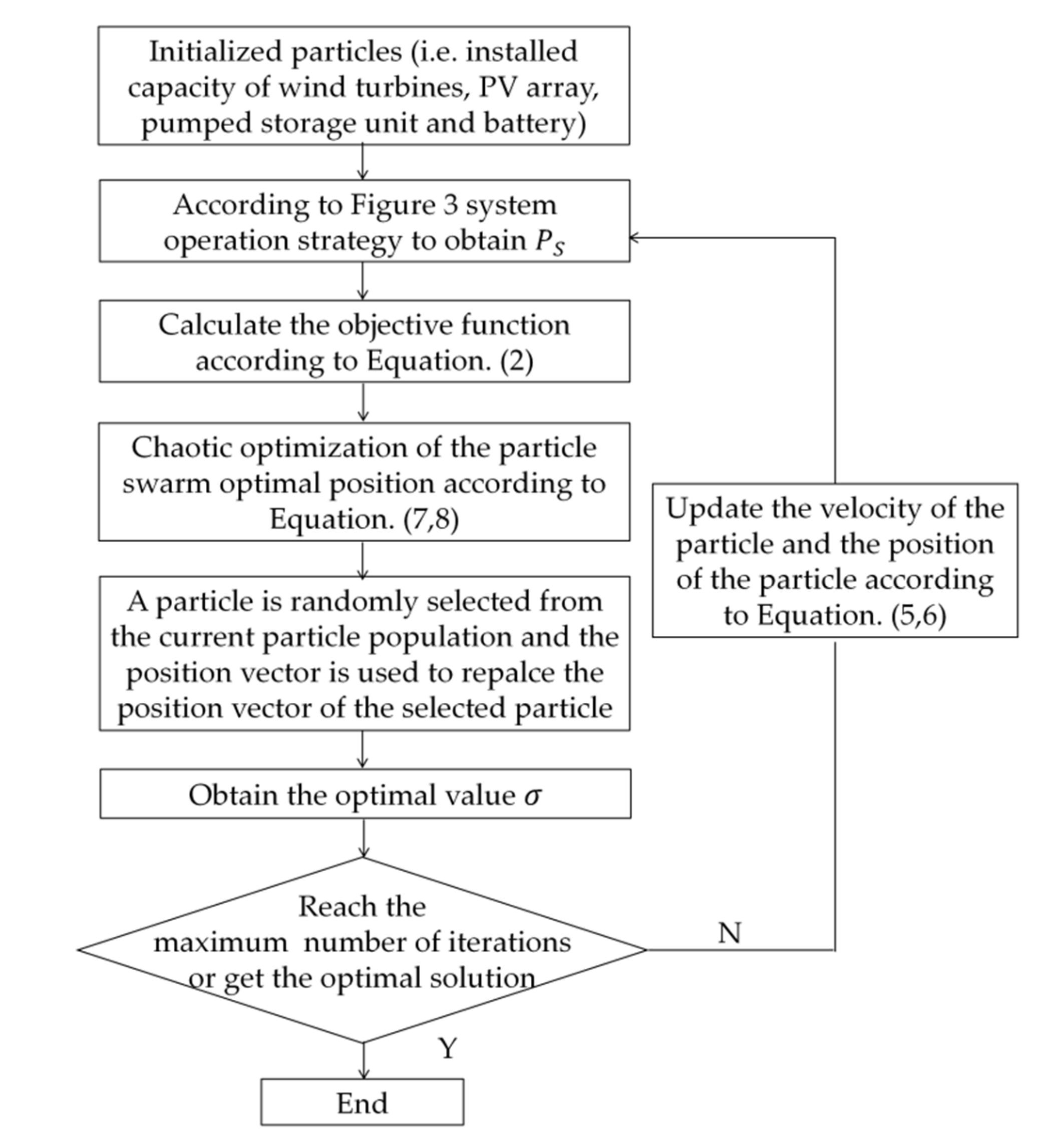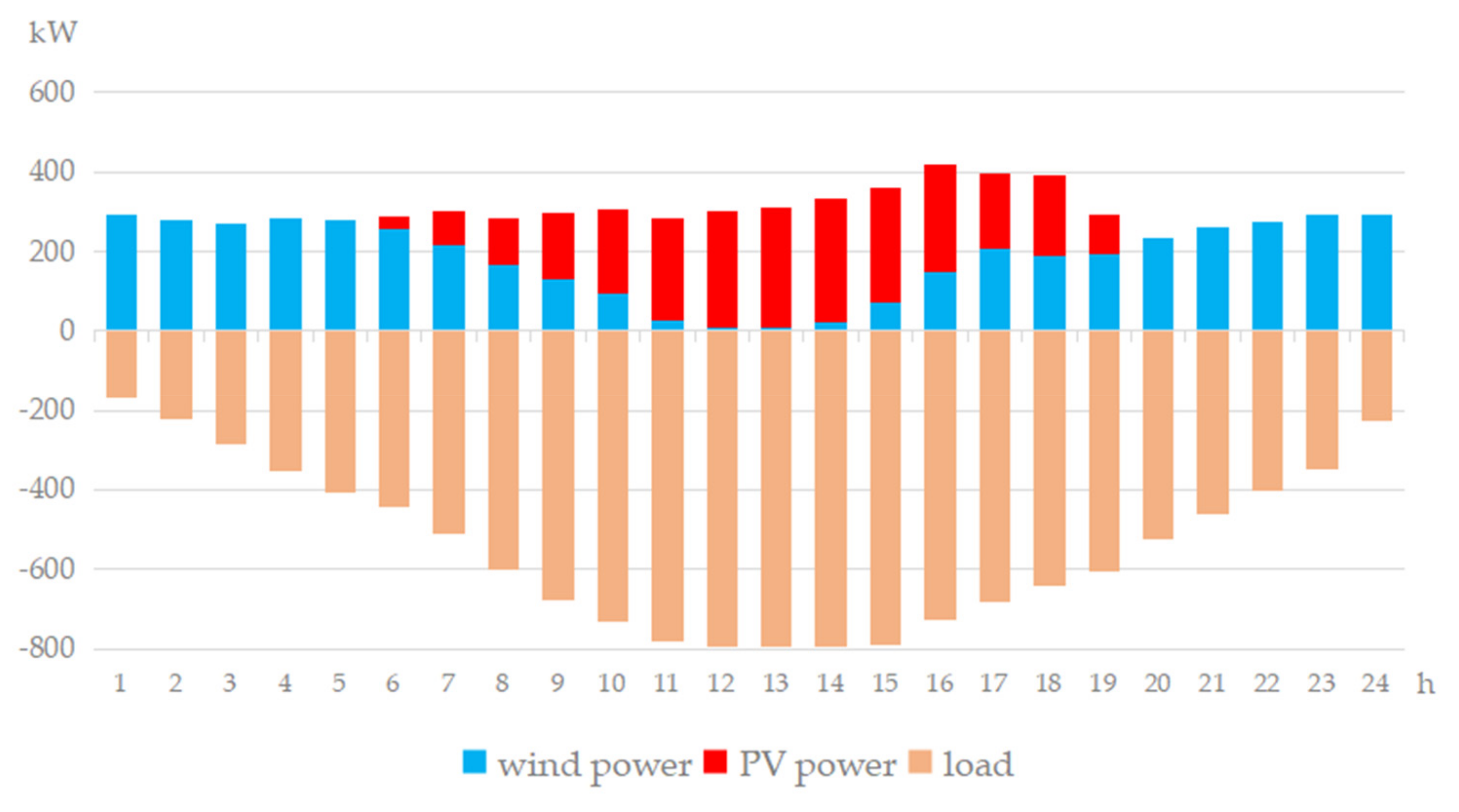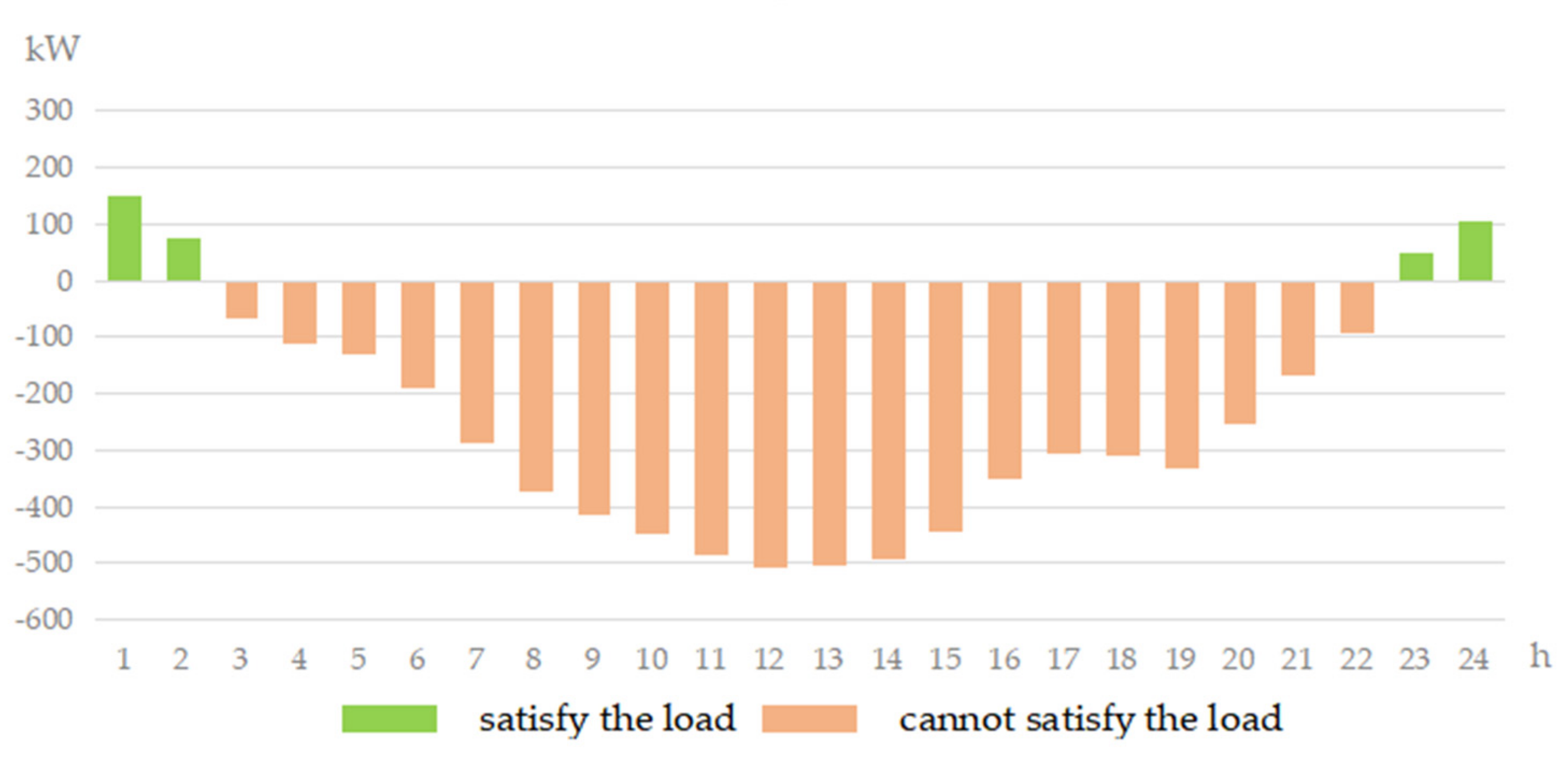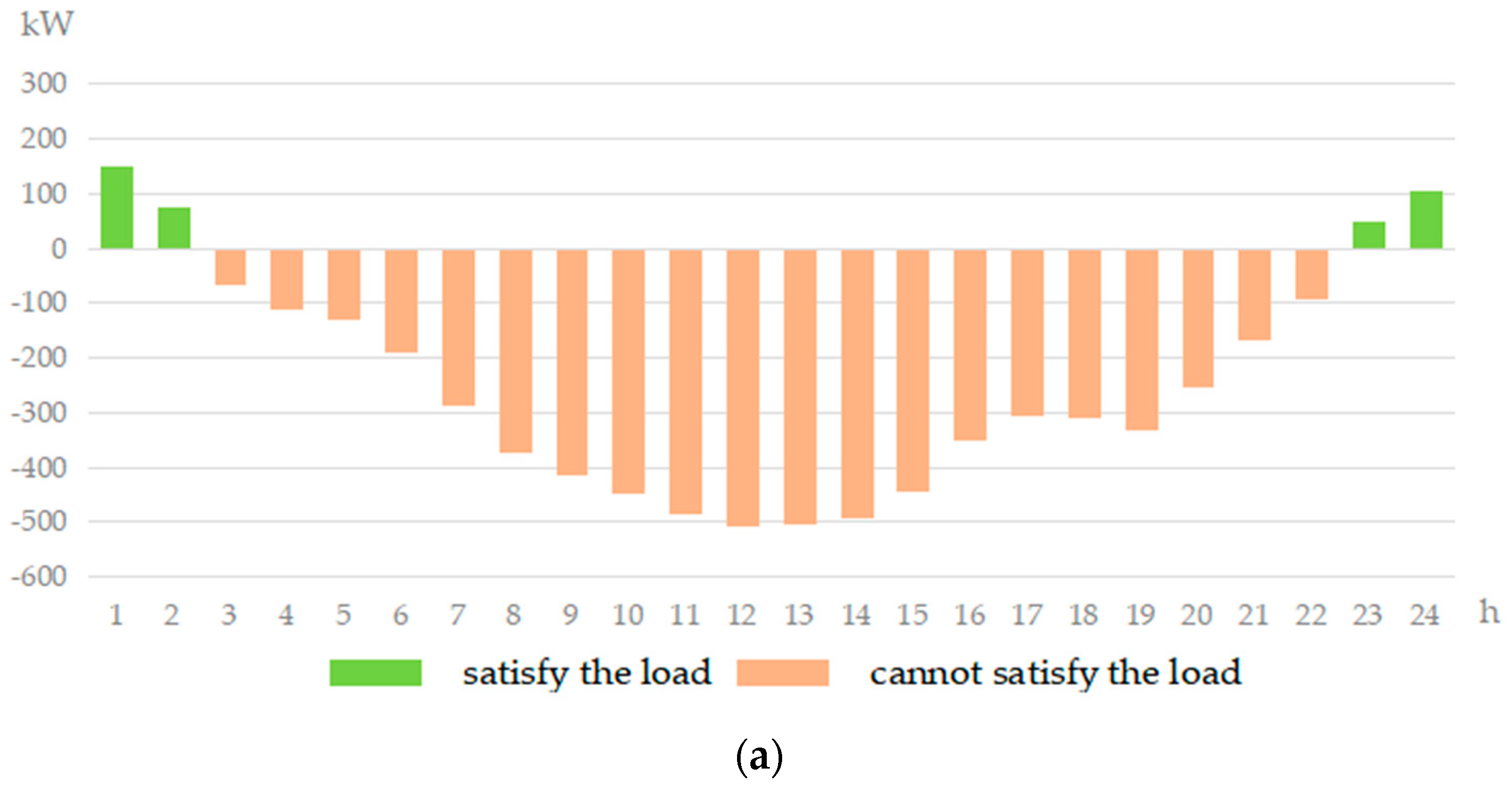Research on the Operational Strategy of the Hybrid Wind/PV/Small-Hydropower/Facility-Agriculture System Based on a Microgrid
Abstract
:1. Introduction
1.1. Literature Review
1.2. Research Gap and Motivation
1.3. Contribution and Paper Organization
- (1)
- A mathematical model of the wind/PV/small-hydropower/facility-agriculture system was established with the load matching degree as the objective function and the power supply reliability as the constraint.
- (2)
- Through the actual data, the control strategy and operation strategy of the wind/PV/small-hydropower/facility-agriculture system were proposed.
- (3)
- The wind/PV/small-hydropower/facility-agriculture system was solved using the CPSO algorithm for the hybrid system, and the operation of the system was analyzed and is discussed.
2. Methods
2.1. System Optimization Design Model
2.1.1. System Optimization Model Building
- —Optimization of the objective function;
- —Constraint condition function;
- —Tolerance factor of the constraint function, ;
- —Optimization variables.
2.1.2. Objective Function
- —The total system power output during calculation period , ;
- —The system load value during calculation period , ;
- —Total number of hours, .
2.1.3. Constraints
- (1)
- Loss of Load Power Rate
- (2)
- Accumulated power deficit
- (3)
- Number of days with guaranteed continuous rainy and windless weather
2.1.4. Selection of Optimization Variables
2.2. CPSO Method for Composite Systems
2.2.1. Detailed Steps
- (1)
- Initializing the particles
- (2)
- Update the velocity and position of the particles
- (3)
- Chaotic optimization of particle swarm optimal positions :
- ①
- Mapping to the definition domain [0, 1] of the logistic equation through Equation (7):where is the control parameter, and are the upper and lower bounds of the value of , respectively.
- ②
- The chaotic sequence is obtained by performing M iterations of the logistic equation for ().
- ③
- The chaotic sequence is mapped back to the original solution space by the inverse of Equation (8):thus generating a sequence of feasible solutions in chaotic variables ().
- ④
- Calculate the adaptation value of each feasible solution vector in the feasible solution sequence, and keep the feasible solution vector corresponding to the optimal adaptation value, denoted as .
- (4)
- A particle is randomly selected from the current particle population, and the position vector of is used to replace the position vector of the selected particle.
- (5)
- Skip to step (2) until the algorithm reaches the maximum number of iterations N or the optimal solution is obtained, i.e., the capacity of the wind turbine, PV array, pumped storage, and battery when the load loss rate of the system is minimized and the initial investment cost of the system is lowest.
2.2.2. Calculation Process
3. Example Analysis
3.1. System Construction
3.2. Optimization of the Scheduling Method of the Hybrid System
3.3. Operating Strategy of the Hybrid System
3.3.1. Wind and PV Power Generation Strategies
3.3.2. Operation Strategy of the Small Hydropower Stations
- (1)
- When wind and PV power cannot meet the load demand, i.e., , the small hydropower stations supply power to satisfy the load.
- ①
- If , the small hydropower stations supply power to the batteries to be charged. If a surplus occurs after the batteries have been fully charged, power is supplied to the power grid.
- ②
- If , other power resources supplement the load.
- (2)
- When wind and PV power do satisfy the load demand, i.e., .
- ①
- If the batteries are fully charged, the small hydropower stations supply power to the grid.
- ②
- If the batteries are not fully charged, the small hydropower stations first supply power to the batteries, after which power is supplied to the power grid when the batteries are fully charged.
3.3.3. Operation Strategy of the Batteries
3.3.4. Operation Strategy of the System
- (1)
- Generation power strategy
- ①
- Wind and PV power first satisfy the load. If there is a surplus, power is supplied to the batteries to be charged. Any remaining power is then supplied to the small hydropower stations for water pumping purposes and finally to the power grid.
- ②
- Small hydropower stations first meet the load demand, and surplus power is then supplied to the batteries to be charged and finally to the power grid.
- (2)
- Consumption power strategy
- (3)
- Battery charging strategy
- (4)
- Pumping strategy of the pumps of the small hydropower stations
3.4. Calculation Results and Discussion
4. Conclusions
- (1)
- The maximum wind power capture control strategy is adopted in wind power generation, and the MPPT control approach is applied in PV power generation, which maximizes wind and solar energy resource utilization. The considered small hydropower generating and pumping systems are independent systems, which increase the system’s operational flexibility.
- (2)
- The operational strategy of the hybrid system is considered in terms of four aspects: power generation strategy, operation strategy, battery charging strategy, and small hydropower pumping strategy. The load should be prioritized in terms of electricity consumption, batteries should be the second priority, and the power grid should be the final priority. This approach guarantees the electricity required for facility agriculture and fully utilizes the various resources.
- (3)
- As China’s largest industry, there are many research results in the field of combining agriculture with clean energy. The research in this paper responds to the carbon peak and carbon neutral requirements proposed by China. Clean energy is certain to be vigorously developed in the agricultural industry, and the development model of “multiple complementary clean energy sources + agriculture” will have far-reaching implications for the sustainable green development of China and the world.
Author Contributions
Funding
Institutional Review Board Statement
Informed Consent Statement
Data Availability Statement
Conflicts of Interest
References
- Wang, T.; Wu, G.; Chen, J.; Cui, P.; Chen, Z.; Yan, Y.; Zhang, Y.; Li, M.; Niu, D.; Li, B.; et al. Integration of solar technology to modern greenhouse in China: Current status, challenges and prospect. Renew. Sustain. Energy Rev. 2017, 70, 1178–1188. [Google Scholar]
- Martínez-Rodríguez, B.; Bilbao-Arechabala, S.; Jorge-Hernandez, F. Security Architecture for Swarms of Autonomous Vehicles in Smart Farming. Appl. Sci. 2021, 11, 4341. [Google Scholar]
- Gupta, M.; Abdelsalam, M.; Khorsandroo, S.; Mittal, S. Security and privacy in smart farming: Challenges and opportunities. IEEE Access 2020, 8, 34564–34584. [Google Scholar]
- Wang, Y.; Niu, H.; Yang, L.; Wang, W.; Liu, F. An optimization method for local consumption of photovoltaic power in a facility agriculture micro energy network. Energies 2018, 11, 1503. [Google Scholar]
- Symeonaki, E.G.; Arvanitis, K.G.; Piromalis, D.D. Current trends and challenges in the deployment of IoT technologies for climate smart facility agriculture. Int. J. Sustain. Agric. Manag. Inform. 2019, 5, 181–200. [Google Scholar]
- Tabor, D.P.; Roch, L.M.; Saikin, S.K.; Kreisbeck, C.; Sheberla, D.; Montoya, J.H.; Dwaraknath, S.; Aykol, M.; Ortiz, C.; Tribukait, H.; et al. Accelerating the discovery of materials for clean energy in the era of smart automation. Nat. Rev. Mater. 2018, 3, 5–20. [Google Scholar]
- Hou, R.; Li, S.; Chen, H.; Ren, G.; Gao, W.; Liu, L. Coupling mechanism and development prospect of innovative ecosystem of clean energy in smart agriculture based on blockchain. J. Clean. Prod. 2021, 319, 128466. [Google Scholar]
- Ma, T.; Javed, M.S. Integrated sizing of hybrid PV-wind-battery system for remote island considering the saturation of each renewable energy resource. Energy Convers. Manag. 2019, 182, 178–190. [Google Scholar]
- Zhang, H.; Lu, Z.; Hu, W.; Wang, Y.; Dong, L.; Zhang, J. Coordinated optimal operation of hydro–wind–solar integrated systems. Appl. Energy 2019, 242, 883–896. [Google Scholar]
- Peng, Z.; Chen, X.; Yao, L. Research status and future of hydro-related sustainable complementary multi-energy power generation. Sustain. Futures 2021, 3, 100042. [Google Scholar]
- Tang, Y.; Fang, G.; Tan, Q.; Wen, X.; Lei, X.; Ding, Z. Optimizing the sizes of wind and photovoltaic power plants integrated into a hydropower station based on power output complementarity. Energy Convers. Manag. 2020, 206, 112465. [Google Scholar] [CrossRef]
- Jakub, J.; Jerzy, M.; Magdalena, K.; Bartłomiej, C.; Mirosław, J. Integrating a wind- and PV-powered hybrid to the power system by coupling it with a hydroelectric power station with pumping installation. Energy 2018, 144, 549–563. [Google Scholar]
- Golzar, F.; Heeren, N.; Hellweg, S.; Roshandel, R. A comparative study on the environmental impact of greenhouses: A probabilistic approach. Sci. Total Environ. 2019, 675, 560–569. [Google Scholar]
- Martinho, V.J.P.D. Energy consumption across European Union farms: Efficiency in terms of farming output and utilized agricultural area. Energy 2016, 103, 543–556. [Google Scholar]
- Calderon, J.; Cureg, J.; Diaz, M.; Guzman, J.; Rudd, C.; Le, H.T. Smart Agriculture: An Off-Grid Renewable Energy System for Farms using Wind Power and Energy Storage. In Proceedings of the 2019 IEEE Power & Energy Society Innovative Smart Grid Technologies Conference (ISGT), Washington, DC, USA, 17–20 February 2019; pp. 1–5. [Google Scholar]
- Narvarte, L.; Fernández-Ramos, J.; Martínez-Moreno, F.; Carrasco, L.; Almeida, R.; Carrêlo, I. Solutions for adapting photovoltaics to large power irrigation systems for agriculture. Sustain. Energy Technol. Assess. 2018, 29, 119–130. [Google Scholar]
- Marucci, A.; Cappuccini, A. Dynamic photovoltaic greenhouse: Energy balance in completely clear sky condition during the hot period. Energy 2016, 102, 302–312. [Google Scholar]
- Li, C.; Zhou, J.; Ouyang, S.; Ding, X.; Chen, L. Improved decomposition-coordination and discrete differential dynamic programming for optimization of large-scale hydropower system. Energy Convers. Manag. 2014, 84, 363–373. [Google Scholar]
- Preitl, Z.; Precup, R.E.; Tar, J.K.; Takács, M. Use of multi-parametric quadratic programming in fuzzy control systems. Acta Polytech. Hung. 2006, 3, 29–43. [Google Scholar]
- Chen, L.; Chang, F. Applying a real-coded multi-population genetic algorithm to multi-reservoir operation. Hydrol. Processes 2007, 21, 688–698. [Google Scholar]
- Moeini, R.; Afshar, M. Arc-based constrained ant colony optimisation algorithms for the optimal solution of hydropower reservoir operation problems. Can. J. Civ. Eng. 2011, 38, 811–824. [Google Scholar]
- Čiča, Đ.; Zeljković, M.; Tešić, S. Dynamical contact parameter identification of spindle-holder-tool assemblies using soft computing techniques. Facta Univ. Ser. Mech. Eng. 2020, 18, 565–577. [Google Scholar]
- Xu, W.; Zhou, D.; Huang, X.; Lou, B.; Liu, D. Optimal allocation of power supply systems in industrial parks considering multi-energy complementarity and demand response. Appl. Energy 2020, 275, 115407. [Google Scholar]
- Kefale, H.A.; Getie, E.M.; Eshetie, K.G. Optimal design of grid-connected solar photovoltaic system using selective particle swarm optimization. Int. J. Photoenergy 2021, 2021, 6632859. [Google Scholar]
- Xu, X.; Hu, W.; Cao, D.; Huang, Q.; Chen, C.; Chen, Z. Optimized sizing of a standalone PV-wind-hydropower station with pumped-storage installation hybrid energy system. Renew. Energy 2020, 147, 1418–1431. [Google Scholar]
- Zapata, H.; Perozo, N.; Angulo, W.; Contreras, J. A hybrid swarm algorithm for collective construction of 3D structures. Int. J. Artif. Intell. 2020, 18, 1–18. [Google Scholar]
- Precup, R.E.; David, R.C.; Roman, R.C.; Szedlak-Stinean, A.I.; Petriu, E.M. Optimal tuning of interval type-2 fuzzy controllers for nonlinear servo systems using Slime Mould Algorithm. Int. J. Syst. Sci. 2021, 1–16. [Google Scholar] [CrossRef]
- Assad, A.; Deep, K. A Hybrid Harmony search and Simulated Annealing algorithm for continuous optimization. Inf. Sci. 2018, 450, 246–266. [Google Scholar]
- Colantoni, A.; Monarca, D.; Marucci, A.; Cecchini, M.; Zambon, I.; Di Battista, F.; Maccario, D.; Saporito, M.G.; Beruto, M. Solar Radiation Distribution inside a Greenhouse Prototypal with Photovoltaic Mobile Plant and Effects on Flower Growth. Sustainability 2018, 10, 855. [Google Scholar]
- Alayi, R.; Mohkam, M.; Seyednouri, S.R.; Ahmadi, M.H.; Sharifpur, M. Energy/Economic Analysis and Optimization of On-Grid Photovoltaic System Using CPSO Algorithm. Sustainability 2021, 13, 12420. [Google Scholar]
- Xue, M.D.; Zhao, B.; Zhang, X.S.; Gao, X.; Jiang, Q. Economic Dispatch of Stand-alone Photovoltaic-Battery-Hydro-Diesel Hybrid Microgrid Based on Distributed Control. Autom. Electr. Power Syst. 2014, 38, 1–7. [Google Scholar]
- Poudel, S.; Dubey, A. Critical Load Restoration Using Distributed Energy Resources for Resilient Power Distribution System. IEEE Trans. Power Syst. 2018, 34, 52–63. [Google Scholar]
- Abdelkader, A.; Rabeh, A.; Ali, D.M.; Mohamed, J. Multi-objective genetic algorithm based sizing optimization of a stand-alone wind/PV power supply system with enhanced battery/supercapacitor hybrid energy storage. Energy 2018, 163, 351–363. [Google Scholar]
- Fang, L.; Niu, Y.; Zu, Q.; Wang, S. Energy management strategy based on energy storage equalization technology and transferable load. Int. Trans. Electr. Energy Syst. 2018, 28, e2599. [Google Scholar]
- Wu, B.; Maleki, A.; Pourfayaz, F.; Rosen, M.A. Optimal design of stand-alone reverse osmosis desalination driven by a photovoltaic and diesel generator hybrid system. Sol. Energy 2018, 163, 91–103. [Google Scholar]
- Chen, L.; Mou, L.; Xu, X.; Liu, S. Influences of energy storage operational strategy and characteristic on microgrid reliability. Electr. Power Autom. Equip. 2017, 37, 70–76. [Google Scholar]
- Ding, H.; Zhang, W.; Chen, M.; Li, S.; Hou, T.; Zhou, X.; Fu, Y.; Liu, Z. Multi-Objective optimial configuration of distributed wind-solar generation considering energy storage. In Proceedings of the 2018 2nd IEEE Conference on Energy Internet and Energy System Integration (EI2), Beijing, China, 20–22 October 2018; pp. 1–6. [Google Scholar]
- Lan, G.J.; Li, W.Y.; Yin, K. Control strategy of wind/photovoltaic/storage micro-grid based on combined energy storage solutions. China J. Power Sci. 2015, 39, 2503–2506. [Google Scholar]
- Yan, R.; Yuan, Z. Optimal design of PV/wind/pumped-storage hybrid system based on improved particle swarm optimization. Adv. Sci. Lett. 2012, 6, 660–663. [Google Scholar]
- Ren, Y.; Zheng, Y.; Li, C.; Zhou, B.; Mao, Z.H. Intelligent optimization of hybrid wind/PV/pumped-storage power system. In Advanced Materials Research; Trans Tech Publications Ltd.: Hamburg, Germany, 2012; pp. 719–722. [Google Scholar]
- Ren, Y.; Yao, X.; Liu, D.; Qiao, R.; Zhang, L.; Zhang, K.; Jin, K.; Li, H.; Ran, Y.; Li, F. Optimal design of hydro-wind-PV multi-energy complementary systems considering smooth power output. Sustain. Energy Technol. Assess. 2021, 50, 101832. [Google Scholar]
- Zhang, K.; Yu, J.; Ren, Y. Demand side management of energy consumption in a photovoltaic integrated greenhouse. Int. J. Electr. Power Energy Syst. 2021, 134, 107433. [Google Scholar]
- Zhang, K.; Yu, J.; Ren, Y. Research on the size optimization of photovoltaic panels and integrated application with Chinese solar greenhouses. Renew. Energy 2021, 182, 536–551. [Google Scholar]
- Tuballa, M.L.; Abundo, M.L. A review of the development of Smart Grid technologies. Renew. Sustain. Energy Rev. 2016, 59, 710–725. [Google Scholar]
- Morris, D.W.; Blekkenhorst, N. Wind energy versus sustainable agriculture: An Ontario perspective. J. Rural. Community Dev. 2017, 12, 23–33. [Google Scholar]
- Petrović, M.; Vuković, N.; Mitić, M.; Miljković, Z. Integration of process planning and scheduling using chaotic particle swarm optimization algorithm. Expert Syst. 2016, 64, 569–588. [Google Scholar]
- Dursun, E.H.; Koyuncu, H.; Kulaksiz, A. A novel unified maximum power extraction framework for PMSG based WECS using chaotic particle swarm optimization derivatives. Eng. Sci. Technol. Int. J. 2021, 24, 158–170. [Google Scholar]








Publisher’s Note: MDPI stays neutral with regard to jurisdictional claims in published maps and institutional affiliations. |
© 2022 by the authors. Licensee MDPI, Basel, Switzerland. This article is an open access article distributed under the terms and conditions of the Creative Commons Attribution (CC BY) license (https://creativecommons.org/licenses/by/4.0/).
Share and Cite
Ren, Y.; Ren, L.; Zhang, K.; Liu, D.; Yao, X.; Li, H. Research on the Operational Strategy of the Hybrid Wind/PV/Small-Hydropower/Facility-Agriculture System Based on a Microgrid. Energies 2022, 15, 2466. https://doi.org/10.3390/en15072466
Ren Y, Ren L, Zhang K, Liu D, Yao X, Li H. Research on the Operational Strategy of the Hybrid Wind/PV/Small-Hydropower/Facility-Agriculture System Based on a Microgrid. Energies. 2022; 15(7):2466. https://doi.org/10.3390/en15072466
Chicago/Turabian StyleRen, Yan, Linmao Ren, Kai Zhang, Dong Liu, Xianhe Yao, and Huawei Li. 2022. "Research on the Operational Strategy of the Hybrid Wind/PV/Small-Hydropower/Facility-Agriculture System Based on a Microgrid" Energies 15, no. 7: 2466. https://doi.org/10.3390/en15072466
APA StyleRen, Y., Ren, L., Zhang, K., Liu, D., Yao, X., & Li, H. (2022). Research on the Operational Strategy of the Hybrid Wind/PV/Small-Hydropower/Facility-Agriculture System Based on a Microgrid. Energies, 15(7), 2466. https://doi.org/10.3390/en15072466







